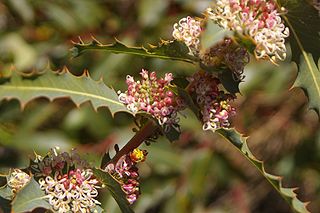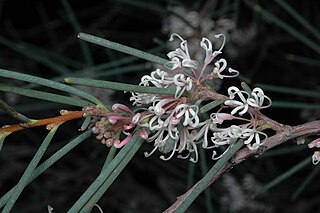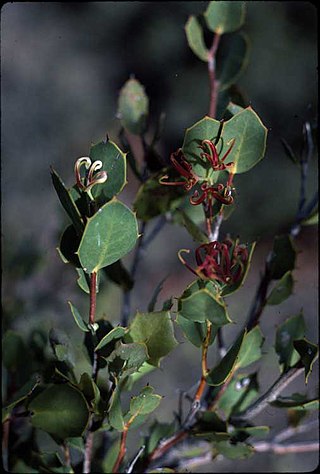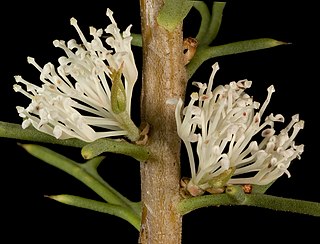
Hakea corymbosa, commonly known as the cauliflower hakea is a plant of the family Proteaceae which is endemic to the south-west of Western Australia. An attractive extremely prickly bush with sweetly scented yellowish flowers. The nectar rich blooms and dense form provides a good habitat for wildlife.

Hakea cygna, commonly known as the swan hakea, is usually a dense shrub endemic to Western Australia with creamy-white upright flowers appearing from July to August.

Hakea amplexicaulis, commonly known as prickly hakea, is a shrub endemic to south west Western Australia. An attractive small shrub with unusual stem clasping, sharply serrated foliage and a profusion of sweetly scented variable coloured flowers from late winter to spring.

Hakea decurrens, commonly known as bushy needlewood, is a species of shrub or small tree in the family Proteaceae.

Hakea trifurcata, commonly known as two-leaf, two-leaved hakea, or kerosene bush, is a shrub, endemic to the south-west of Western Australia. The species has two leaf forms, needle-like or oblong egg-shaped. Unlike most hakea species the fruit remain green at maturity and resemble the broader leaf form. The mimicry creates a camouflage, reducing predation of the seed by granivores in particular cockatoos.

Hakea rugosa, commonly known as wrinkled hakea or dwarf hakea, is a shrub of the family Proteaceae native to Australia. It has sharp needle-shaped leaves and white or cream fragrant flowers in profusion from August to October.

Hakea cycloptera, commonly known as elm-seed hakea, is a shrub in the family Proteaceae endemic to South Australia. It is a small spreading shrub with an abundance of pale pink or white flowers from December to August.

Hakea denticulata, commonly known as stinking Roger is a shrub tree endemic southern Western Australia. One of the many species of Australian plant described by the botanist Robert Brown. A compact shrub 1–2 m (3–7 ft) high and wide with red flowers in the spring with an unpleasant odour.

Hakea chordophylla, commonly known as bootlace oak, bootlace tree, corkwood, or bull oak, is a species of shrub or small tree in the family Proteaceae found in central and northern Australia. Bears very showy golden yellow, pale green or cream nectar rich flowers in winter.

Hakea commutata is a shrub in the family Proteaceae native to Western Australia. A variable species in shape and growing requirements, including mallee heath, sand and along creek lines.

Hakea leucoptera, commonly known as silver needlewood, needle hakea, pin bush or water tree and as booldoobah in the Koori language, is a shrub or small tree with rigid, cylindrical, sharply pointed leaves and white, cream-coloured or yellow flowers in late spring and early summer. It is widespread and common in central parts of the Australian mainland.

Hakea anadenia is a shrub in the family Proteaceae, native to near the west coast of Western Australia. The fragrant creamy-white flowers appear in profusion from late winter to spring, but do not produce nectar.

Hakea elliptica, commonly known as the oval-leaf hakea, is a shrub in the family Proteaceae and is endemic to Western Australia. A fast growing adaptable species with ornamental wavy leaves, golden bronze new growth and an abundance of showy white flowers. A good wildlife habitat due to its dense form with foliage to ground level.

Hakea ilicifolia is an open shrub or tree in the family Proteaceae and is endemic to Western Australia. It is a small, dense shrub with stiff, lobed leaves and clusters of yellow or creamy-white flowers.

Hakea kippistiana is a shrub in the family Proteaceae and endemic to Western Australia. It is a dense prickly shrub with sharp needle-shaped leaves with fragrant white, cream or pink flowers from November to February.

Hakea varia, commonly known as the variable-leaved hakea, is a shrub of the family Proteaceae and is endemic to Wheatbelt, South West, Great Southern and Goldfields-Esperance regions of Western Australia. It is a dense prickly shrub with creamy-white or yellow flowers and variably shaped leaves.

Hakea obliqua, commonly known as needles and corks, is a shrub in the family Proteaceae and is endemic to an area in the Wheatbelt, Great Southern and Goldfields-Esperance regions of Western Australia.

Hakea vittata, commonly known as the striped hakea, hooked needlewood, is a shrub of the family Proteaceae. Restricted to an area on the Eyre Peninsula and the Gawler Range in South Australia and small areas in eastern Victoria.

Hakea oldfieldii is a shrub of the family Proteaceae and is endemic to South West region of Western Australia. It has small white or cream-yellow flowers in profusion in spring.
Hakea leucoptera subsp. sericipes is a small tree with cylinder-shaped leaves and clusters of up to forty-five white fragrant flowers. It is found in northwestern New South Wales, Queensland and Western Australia.




















